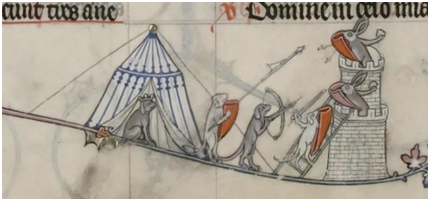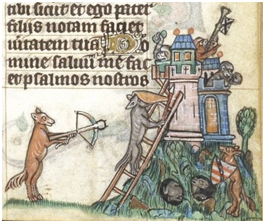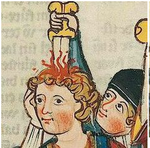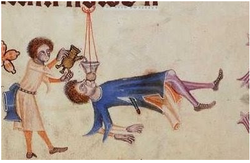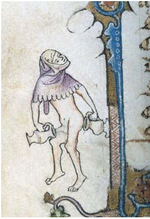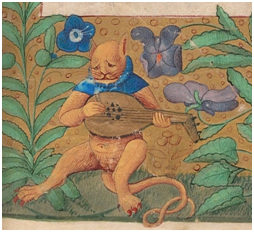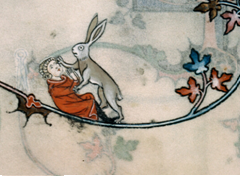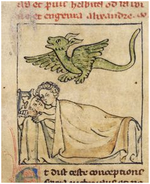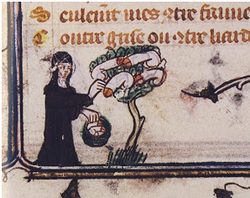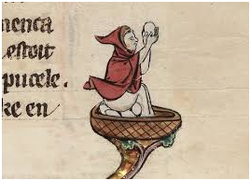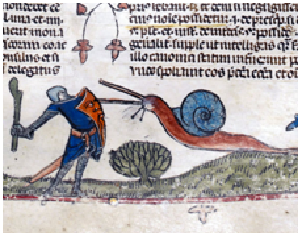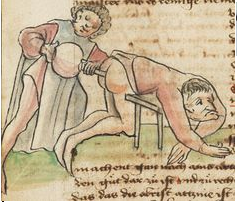Medieval Marginalia
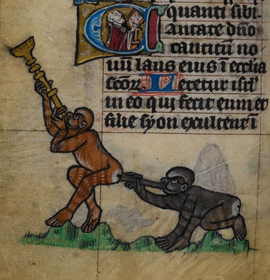
“It's a Middle, Middle, Middle, Middle Aged World”
“Sod hoc sancto negotio. Volo et modicum vivere. Matrum![1]”
In a world without the benefit of the internet it could take decades for cat memes to circulate throughout Europe while an email could take several months to deliver - a speed surpassed by AOL as long ago as 2014. So how could news be efficiently spread to an illiterate, turnip-obsessed public? The answer was to use illustrations to convey complex ideas. Chaucer himself records the latest treatise on hamster rearing arriving in Chichester and the peasantry pouring over its sage advice even while they coughed out their intestines during the Great Scratching Sickness of 1364.
Hygiene standards were low in the Medieval World, leading to endemic dysentery and a consequent chronic paper shortage[2]. Scribes took the sensible decision to pass on their knowledge in the spaces alongside the script of a popular self-help book of the day, The Holy Bible. The superstitious psycho-babble of this frankly bizarre publication now seems as incomprehensible as it is dated, but the wisdom of the Medieval Marginalia often hidden in its darkest corners speaks to us down the ages.
Warfare
When Shakespeare has Mark Antony deliver the immortal line “Cry ‘Havoc’, and let slip the Dogs of War” he is, of course, confusing the tactics of Ancient World with those of his own day. Havoc was an an order to an army to begin to pillage and cause chaos (echoed in the blowing of a whistle to signal the start of a game of Rugby, accompanied by the cry “Have it!” from the crowd). “The Dogs of War” has long been interpreted as a metaphor for soldiers but careful perusal of Medieval Marginalia shows that Henry V’s success during the siege of Harfleur was, at least in part, down to highly trained Dogs of War, skilled in the use of the English Long Bow and siege ladders.
Note that the success of the English in the first decades of the Hundred Years' War might be ascribed to early French attempts to defend their strongholds with armies of mercenary rabbits. Later, use of Genoese Capuchin monkeys made storming Amiens a much harder prospect.
Historians have debated the apparent absence of "Hogs of War" from most accounts of Medieval warfare. For centuries the accepted logic for this failure to utilise the martial qualities of swine was their uncleanliness, as set out in the Book of Leviticus. In recent years, however, academics have begun to suggest that their absence from conflicts of the day may have had more to do with the inability of slow-moving land-forces to transport tasty critters cross-country without encountering enemy troops, fire and frying pans.
Medicine
In some ways diagnosis and prescription of treatment in the Middle Ages was a simpler affair than today:
| “ | You appear to be bipolar. This is due to an excess of Black Bile. For eight days apply four fresh leeches exactly three inches apart to your left arm each time the monastery bell tolls. Drown said leeches in Malmsey wine and sit in your hovel for two weeks without eating or washing*” | ” |
*sitting in a hovel for two weeks without eating or washing was not part of the treatment. It was considered to be proof of its success since it was a return to an everyday mode of life.
| “ | For the fifth time this year you’ve been arrested by the town constable for fighting in a tavern. You have an excess of Yellow Bile. For eight days apply four fresh leaches exactly three inches apart to your left arm each time the monastery bell tolls. Return to the tavern and have them manacle you to the wall. Continue drinking until everyone becomes your very best mate and you have always loved them even if they are all a bunch of c**ts. | ” |
| “ | You have been wearing your wife’s dress and standing on street corners soliciting passing cart-drivers. You have an excess of Phlegm. For eight days apply four fresh leeches exactly three inches apart to your left arm each time the monastery bell tolls. If you still do not desire your wife, join the monastery where a life of devotion to God may save your soul, and at the very least you will be popular with the younger brothers after Vespers[3]. | ” |
Music
Medieval music could be tiresome. As REM repeatedly demonstrated, it is possible to hear too much of the mandolin. And which of us has not turned off The X Factor when yet another Dulcimer-instrumentalist has been put through to the Grand Final despite having a sound that compares poorly to four cats being strangled? Medieval people had considerably more experience of cat-strangling than most modern adults outside Louisiana but how many of us have shared the experience of listening to cats making music that was so common in the thirteenth century?
The nose-flute is today limited to Pacific islands where interfering with fish is the only other entertainment opportunity. But in the 1300’s it was widespread in Europe, its popularity rivaled only by the ear-lute, chin-piano and arse-trumpet.
Dancing could be dangerous in Early Modern England. Women who danced were frequently accused of lasciviousness and cast-out of their homes, condemned to live out the rest of their lives as whores. Men who expressed an interest in dance were viewed with extreme suspicion, forbidden from joining local sporting societies and excluded from a radius of 200 metres of all boys’ schools. Local bye-laws to this effect still apply in Sunderland
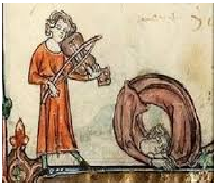
Sexuality
Sexuality in Medieval Europe was strictly controlled by the Church. Any form of sexual expression that did not lead to an increase in population was seen as ungodly and strictly policed, much as it is in modern-day Las Vegas.
In 1198 Roger DeCourcey was found in flagrante with a young bear cub. Despite being Earl of Chester he was publicly flogged, branded and his ears, nose and virile member cut off and fed to the disgraced bear, which was subsequently hanged. Roger himself slowly bled to death while being gnawed by squirrels – a relatively lenient punishment that would not have been available to anyone outside the upper ranks of nobility.
Even when sexual liaisons were kept within more traditional species-limits the Vatican insisted that all couplings utilised the orthodox “Crusader-position”. In a bull of 1364 Pope Urban V explicitly forbade “ye coupling known as “Oxen-girl wherein maidens at the behest of Satan bestride a man with the purpose of sucking out his very soul with their ungodly front-bottoms”. “Reverse Oxen-girl” was made punishable by dissolving in vitriol followed by evaporation.
Homosexuality was, of course, strictly out of the question with indulgences only for Princes of Royal blood and Italians. Despite this the sin of Eve meant that the church maintained an uneasier relationship with women than one might imagine from an all-male, celibate establishment. The two illustrations below served to warn how wanton females could not be trusted.
The first suggests that any woman left unsupervised by their husband would seek out the forbidden fruit of the then-widespread Schlong-Tree. The second that, where possible, men should avoid allowing their wives to incubate foetuses in the womb if they had the time and leisure to sit on the eggs themselves.
Snails
It has long been thought that God created snails after a heavy Jaeger-bomb session. That he insisted on Noah saving them while neglecting to save the Unicorn is frankly inexplicable. Of course, these disgusting terrestrial pulmonate gastropod molluscs are an agricultural menace and, as such, remain a threat to the health and well-being of all. What is less well known is that until 1427 they remained a direct threat to humanity due to their enormous size and vicious predatory instincts.
In one of the triumphs of Medieval Marginalia, Geoffrey of Monmouth[4] convinced the nobility of Europe to co-opt snails into warfare – horses having yet to develop from the dog-sized, forest-dwelling Eohippus due to the impossibility of evolution according to Biblical interpretation. This significantly lessened the mortality rate in Medieval battles[5] and it is thought that the habit of eating the remains of dead mounts after a battle led directly to today's revolting continental habit of eating both snails and horses.
The Modern Day
It is easy to sneer at some of the advice passed on to our forebears in the margins of Medieval manuscripts but that is to view these documents through modern eyes. The hard-working gong-farmers of sixteenth century London lacked access to the electronic media we take for granted. Without the wisdom of Gwyneth Paltrow they could never learn that fundamental flaws in the Feng Shui of their thatched slum would lead to stomach ulcers - even in the unlikely event of them surviving their infectious life among the cess-pits of Cheapside long enough to suffer age-related conditions. But her assertion that colonic irrigation is the key to a long, healthy life was anticipated centuries before.
References
- ↑ Sod this saint business.I want to go out and live a little. Breasts!
- ↑ China held the patents for paper making.
- ↑ Roman Catholic bishops riding scooters.
- ↑ Charlatan, mounteback, faker, false standard ops etc.etc...
- ↑ Health & Safety was at a medieval minimum then.You were as likely to die from the attentions of quack doctors rather than a sword thrust targetting your innards.
See also
| Featured version: 25 September 2016 | |
| This article has been featured on the main page. — You can vote for or nominate your favourite articles at Uncyclopedia:VFH. | |
